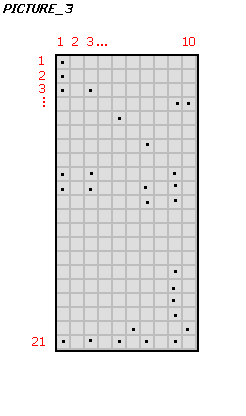
| SEq-Blaster
music file format (for 1.0.j version) |
This format is basically a text file containing information for the player.
*blue text=.SEQ file content *black text=descriptions/comments
-First 3 lines: (common header)
SEq-BLASTER FILE V.1.0.J // If version below 1.0.j then the file is old.
For 1.0.g files, use the SEQ-Blaster
program 'Guardar como' for G to J format conversion.
Copyright(c) .HCC. ~Software~ -1997/98- //
// -Blank line-
-In the 4th line the text strings begin: (9 lines)
[Titulo] // common label
Crist // music title
// -Blank line-
[Autor] // common label
Hernan C. // author name
// -Blank line-
[Texto] // common label
Requiere placa de sonido AWE32 o superior // comment text
// -Blank line-
-The 10th line is the beginning of the music parameters: (12 lines)
FormatCONF: // common label
4 // channels (fixed)
19 // pattern sequences (variable)
30 // max. number of patterns (fixed)
32 // max. number of positions per pattern (fixed)
// -Blank line-
SpeedCONF: // common label
222/444 // the second number is not relevant,the first
number is the speed (delay between pos.)
In some songs there is only one number,
then these will be the speed value
(NOTE: higher delay values means lower
playing velocity!)
// -Blank line-
CanalCONF: // common label
1070000320080078042 // channel information (four channels 4 lines)
1070000320080078042 //
1060330320042078042 // !see Picture_1 for detailed information!
0600160320088078042 //
// -Blank line-
Secuencias: // common label
02031303041211050505050606060605050505 // patterns sequence order (1 line, two digits by pattern
for this song 38 digits because 19 * 2)
!see Picture_2 for detailed information!
// -Blank line-
-And now the patterns description: (each pattern is divided into 4 channels)
Patterns: // common label (only appears one time)
// -Blank line-
P01-go // P'pattern number'-go (beginning of pattern)
RC:18 // RC:'carry return point' (1-32)
C1 // C'channel number'(channel into the pattern)
59 // \
030921252627385960 // \
5961 // \
0 // pattern grid representation
''' 32 lines (32 positions per pattern)
20 // !see Picture_3&4 for detailed information!
31375055 // /
23 // /
5660 // /
// -Blank line-
C2 //
''' 32 lines (32 positions per pattern)
//
C3 //
''' 32 lines (32 positions per pattern)
//
C4 //
''' 32 lines (32 positions per pattern)
// -Blank line-
// -Blank line-
P-end // common end pattern marker
*After pattern 1, the pattern 2 and so on (up to pattern 30)
-Finally (below the last P-end marker): (two more lines)
// -Blank line-
Fin // common end file marker
--/--
Example for 10*21 grid pattern: (Please note, real patterns are 32*61)
 |
The way to indicate a Dot/Note
in each column is simply by the row position. (if no
number present then this position is empty). The value 0
is used to indicate a totally empty column. C1 // channel 1 01 02 03 09 10 21 // Column 1 0 // Column 2 03 09 10 21 // Column 3 0 05 21 20 07 10 11 21 0 04 09 10 11 16 17 18 19 21 04 20 // Column 10 *The process is the same for each one of the 4 channels that compose the whole pattern. |
Real pattern scheme:
* Please check the music examples below (.SEQ,.MID and .MP3 format) for a better understanding. Note: the midi files are not .MID converted to .SEQ but .SEQ converted to .MID (the SEq-Blaster program has an export module included). If you want to convert your own SEQ files to MID you may set the speed (beats) manually for better results.
| SEq-Blaster
v.1.0.j -A
simple way to compose MIDI music!- |
Web... -Spanish- [1024 Kb] |
| Example #1 (for wave-table sound cards) | * Awe-1.zip *SEq-Blaster ,Midi and MP3 format. (awe-1.seq; awe-1.mid; awe-1.mp3) |
| Example #2 (for wave-table sound cards) | * Awe-2.zip *SEq-Blaster and Midi format. (awe-2.seq; awe-2.mid) |
| Example #3 (for wave-table sound cards) | * Awe-3.zip *SEq-Blaster and Midi format. (awe-3.seq; awe-3.mid) |
*This material is exclusive property of Random'64 and cannot be used in any other publication without expressed authorization.
Contact Us | Random'64 Home Page | More docs
Copyright © .HCC. ~Software~ -2000- Bs. As. (Argentina) www.geocities.com/hcc.soft , www.emuhq.com/random64